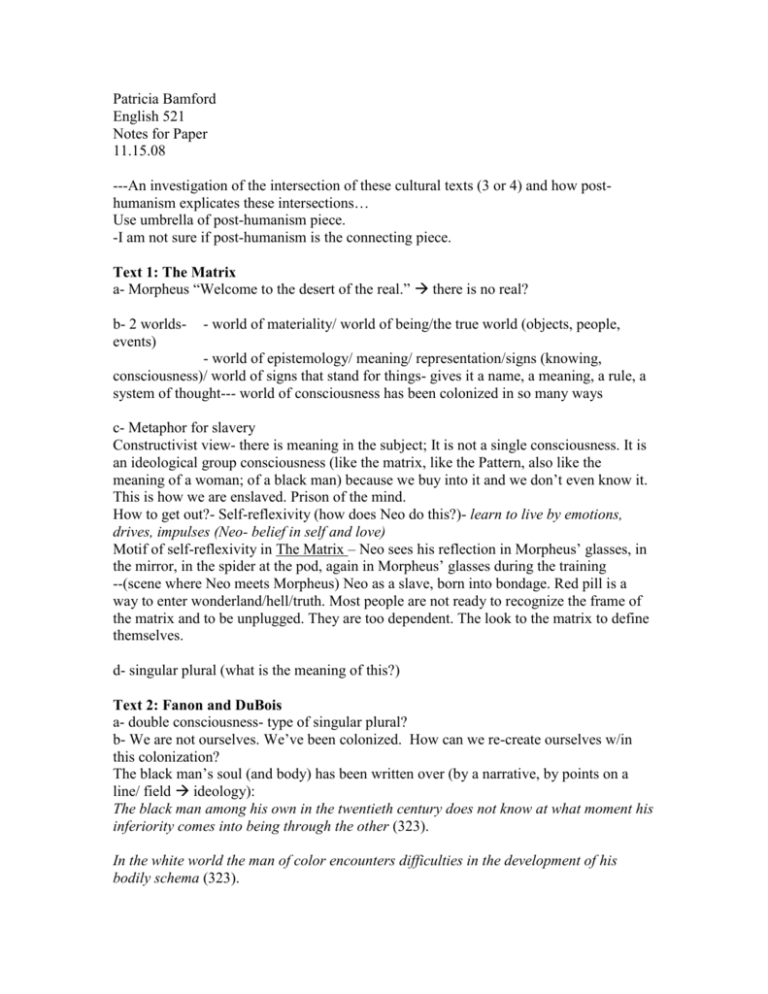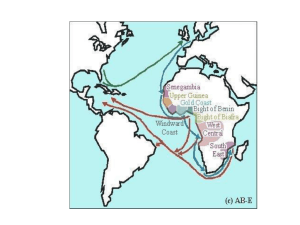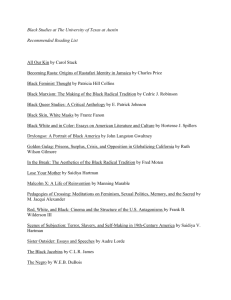patriciabamfordcomments
advertisement

Patricia Bamford English 521 Notes for Paper 11.15.08 ---An investigation of the intersection of these cultural texts (3 or 4) and how posthumanism explicates these intersections… Use umbrella of post-humanism piece. -I am not sure if post-humanism is the connecting piece. Text 1: The Matrix a- Morpheus “Welcome to the desert of the real.” there is no real? b- 2 worldsevents) - world of materiality/ world of being/the true world (objects, people, - world of epistemology/ meaning/ representation/signs (knowing, consciousness)/ world of signs that stand for things- gives it a name, a meaning, a rule, a system of thought--- world of consciousness has been colonized in so many ways c- Metaphor for slavery Constructivist view- there is meaning in the subject; It is not a single consciousness. It is an ideological group consciousness (like the matrix, like the Pattern, also like the meaning of a woman; of a black man) because we buy into it and we don’t even know it. This is how we are enslaved. Prison of the mind. How to get out?- Self-reflexivity (how does Neo do this?)- learn to live by emotions, drives, impulses (Neo- belief in self and love) Motif of self-reflexivity in The Matrix – Neo sees his reflection in Morpheus’ glasses, in the mirror, in the spider at the pod, again in Morpheus’ glasses during the training --(scene where Neo meets Morpheus) Neo as a slave, born into bondage. Red pill is a way to enter wonderland/hell/truth. Most people are not ready to recognize the frame of the matrix and to be unplugged. They are too dependent. The look to the matrix to define themselves. d- singular plural (what is the meaning of this?) Text 2: Fanon and DuBois a- double consciousness- type of singular plural? b- We are not ourselves. We’ve been colonized. How can we re-create ourselves w/in this colonization? The black man’s soul (and body) has been written over (by a narrative, by points on a line/ field ideology): The black man among his own in the twentieth century does not know at what moment his inferiority comes into being through the other (323). In the white world the man of color encounters difficulties in the development of his bodily schema (323). “Look, a Negro!” “Mama, see the Negro! I’m frightened!” My body was given back to me sprawled out, distorted, recolored, clad in mourning in that white winter day” (324). World of representation/ world of signs: internalized prompts connected to images that shape how we see ourselves and others In “The Fact of Blackness,” Fanon alerts us to prompts such as The Negro is an animal, the Negro is bad, the Negro is mean (324). He continues, since I have unthinkingly conceded that the black man is the color of evil… (325). -Self reflexivity (how does Fanon do this?) -Diegesis, hypo-diegeseis, meta-diagesis As I begin to recognize that the Negro is the symbol of sin, I catch myself hating the Negro. But then I recognize that I am a Negro. There are two ways out of this conflict. Either I ask others to pay no attention to my skin, or I want them to be aware of it (325). Then Fanon calls these two choices a “neurotic situation” (double consciousness) and continues: I have only one solution: to rise above this absurd drama that others have staged around me, to reject the two terms that are equally unacceptable, and, through one human being, to reach out for the universal (325). c- ideology that has denigrated, marginalized and othered Text 3: Virtual Bodies and Flickering Signifiers Signifier and signified- the signifier disappears, as the concept (the signified) predominates The signified is produced. It fills the mind with mental representations of the object. It refers to/assigns the meaning of the object. The signifier can be words, sentences… which are filtered through the field of language. Presence/absence; pattern/ randomness p. 263 pay attention to paragraph that starts “I am now in the position to state my thesis…” -de-materialization affects the human and textual bodies –as a change in the body (material substrate/material world) –and a change in the message (the codes/world of representation) -constructing randomness as a pattern through information technologies -the relation between signified and signifier is altered by information technologieschanging modes of signification affect the codes as well as the subjects of representation -pattern can be recognized through repetition of elements (265) -Apply this to Fanon and DuBois -How to apply this to the Matrix? Text 4: Patternmaster a- Metaphor for slavery b- The Pattern has lots of connections with the matrix- enslaved by a pattern/matrix, subject to it, where is the individuality? Where is the freedom? How to achieve freedom within this construct? Post-humanism “Mapping the post/human” – p. 1 watch out for “definitive and authoritative representations of human identity.” This is what we need to question, not unthinkingly accept. p. 2 “In challenging the fixity of ‘human nature’ in this way, the digital and biotechnological age engenders renewed scrutiny of the basic assumptions on which matters such as personal identity, the constitution of community, the grounds of human uniqueness and relationship between body and mind are founded.” p. 3 section ‘Technologization of Human Bodies and Minds” p. 6 ‘Disenchantment’ – Heidegger claimed that technology was not to be understood or approached through its design or function, or even in terms of productive processes, but rather in its potential to ‘enframe’ (Gestell) or yield the inner essence of being….. ‘the essence of technology is by no means anything technological,’ a statement which identifies in technology not only an empirical reality, but a force that may more appropriately be termed ontological. It hints that technologies are more than empirical objects or tools, but possess the capacity to constitute human existence” - What are these technologies? - a power to build worlds and selves (p.7) post-humanism as ‘being is altered by meaning’ -Ontology = being Post-human- no longer matters if it’s personal Patricia, sounds like a powerful project. Just try to gain an overview on your progression of ideas and how one links with the next. I’d also send me three or four pages before you complete it so I can give you some feedback. That is up to you, however.











